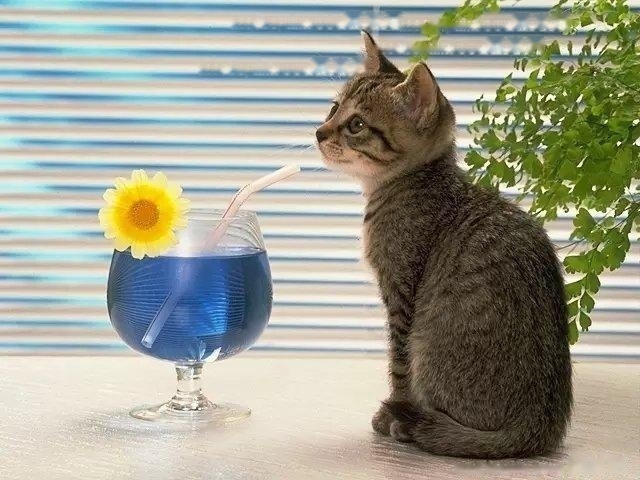Cats belong to the order Mammalia, the order Carnivora, and the feline family. Cats are divided into wild cats and domestic cats, no matter which breed of domestic cats is, they are gradually domesticated and selected from wild cats for thousands of years. Likewise, today's domestic cats will evolve into feral cats if they are released into the wild. Cats still retain wild habits and behavioral characteristics in many places.

1. Lonely by nature, jealous cats like a lonely and free life. Except for mating in heat, they rarely roost together in groups and like to wander around. It does not recognize a specific owner, as long as there is a better food and living environment, it will settle down there. Cats are also jealous, they will be jealous of their peers and even children, so when raising cats, you should have a kind attitude, a bowl of water is level, and pay attention to cultivating your relationship with cats.
2. Smart and affectionate Cats are one of the most intelligent animals. Some people think that everything a dog can do, a cat can learn. However, due to the cat's stubborn character, it does not succumb to its owner's authority, and does not blindly obey the owner's orders. Although the cat has no crying or laughing expressions, there are movements and changes that show joy, anger, sadness and joy. When happy, the ears are raised, the whiskers are relaxed, the tip of the tail is gently swayed, and the pupils are natural. When angry, the ears are raised and swayed back, the tips of the ears are curved inward, the pupils are narrowed to form a slit, the whiskers are raised to the sides, the tail slaps the ground fiercely, and the forelegs lie on the ground, ready to jump at any time. When asking the master to caress, his eyes are slightly closed, his tail is gently waving, he walks back and forth close to his master, and makes a subtle cry, shaking his head and waving his tail coquettishly to his master.
3. Carnivorous omnivorous habits
Cats are carnivorous omnivores. Generally speaking, cats like to eat fish, meat and animal offal, and also eat some cereals such as rice and steamed bread when they are extremely hungry. Of course, cat food selection also has a habit problem. Affected by the owner's eating habits, cats will also change. Some foods (such as fruits) are not eaten by cats even if they are delicious. This may be related to the fact that cats are not interested in sweetness.
4. Cats like to clean. Cats like to clean. They often like to use their tongues to lick their coats or lick their wet paws to wash their faces after eating and playing. This is a physiological need. The purpose of licking the coat is to stimulate the secretion of sebaceous glands, so that the coat is bright and lubricated, and is not easily wetted by water; at the same time, a certain amount of vitamin D can be licked to promote bone growth and development; it can also make the coat It is fluffy and promotes heat dissipation when it is hot; tongue licking also prevents the coat from contracting parasites. Cats have a habit of burying their feces after they defecate. Today it seems that although it has completely lost its original connotation, it has won the reputation of love for cleanliness for cats.
5. Sleeping and nocturnal cats spend about 2/3 of their lives sleeping. Among all domestic mammals, cats have the longest sleep time. Cats don't sleep long at a time, but they sleep many times a day, adding up to a long time. Cats are highly alert animals, and during sleep, they can maintain their ability to respond to their environment in order to quickly regain sufficient fighting strength in a very short period of time. Cats love being relaxed, relaxed and comfortable. Prefers to stay in a warm place on the windowsill, or on a beloved cushion, an important feature of the cat's lifestyle.
Cats still retain the nocturnal habit of carnivores, and many activities (such as mouse-catching, courtship and mating, etc.) are often carried out at night. Various functions of cats are more active at night than during the day.
6. Strong adaptability Cats have strong adaptability, wherever there are humans living, there are cats. Adult cats change their fur once a year in the alternating seasons of spring, summer and autumn and winter to adapt to climate changes.
7. Cat's hunting behavior Hunting is a cat's primitive instinct, because without this instinct, it cannot survive in a wild state. When cats hunt, they first approach their prey quietly, and when they find the target, they will use all possible bunkers to approach the target carefully. The cat then presses its belly against the ground and moves forward in a rapid, sneaking motion, stopping briefly to focus on the prey. Repeat this to reach a shelter close to the prey and wait quietly for the attack. Then, the cat left the cover, kept its body close to the ground, and charged forward quickly. After entering the attacking distance, it raised its front and threw itself on the prey, and then gave the prey a fatal bite.
8. Strong curiosity Cats are very curious, especially young cats, they are very curious about the ball, they often rush forward to the small ball, or use their forefoot to hit and play with the small ball, a small ball Often can play for half a day. It will also pounce on small insects flying in the air, and even if there is nothing in the air, it will pounce on it. Some people think that this is the cat training hunting skills, and there is no need to stop it.
![[Dog Training 5] The training method of pet dog dining etiquette](/static/img/12192/12192_1.jpg)




